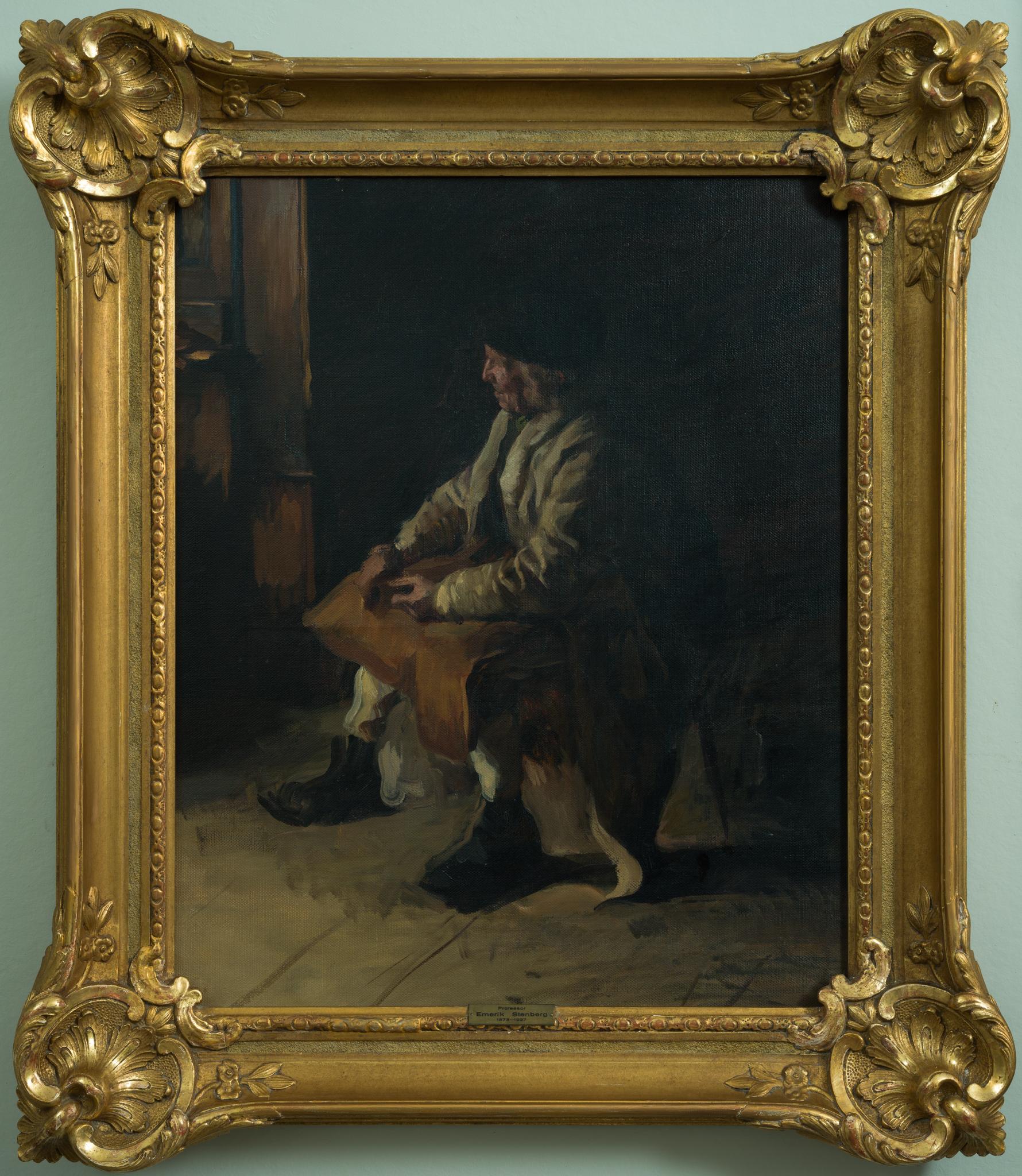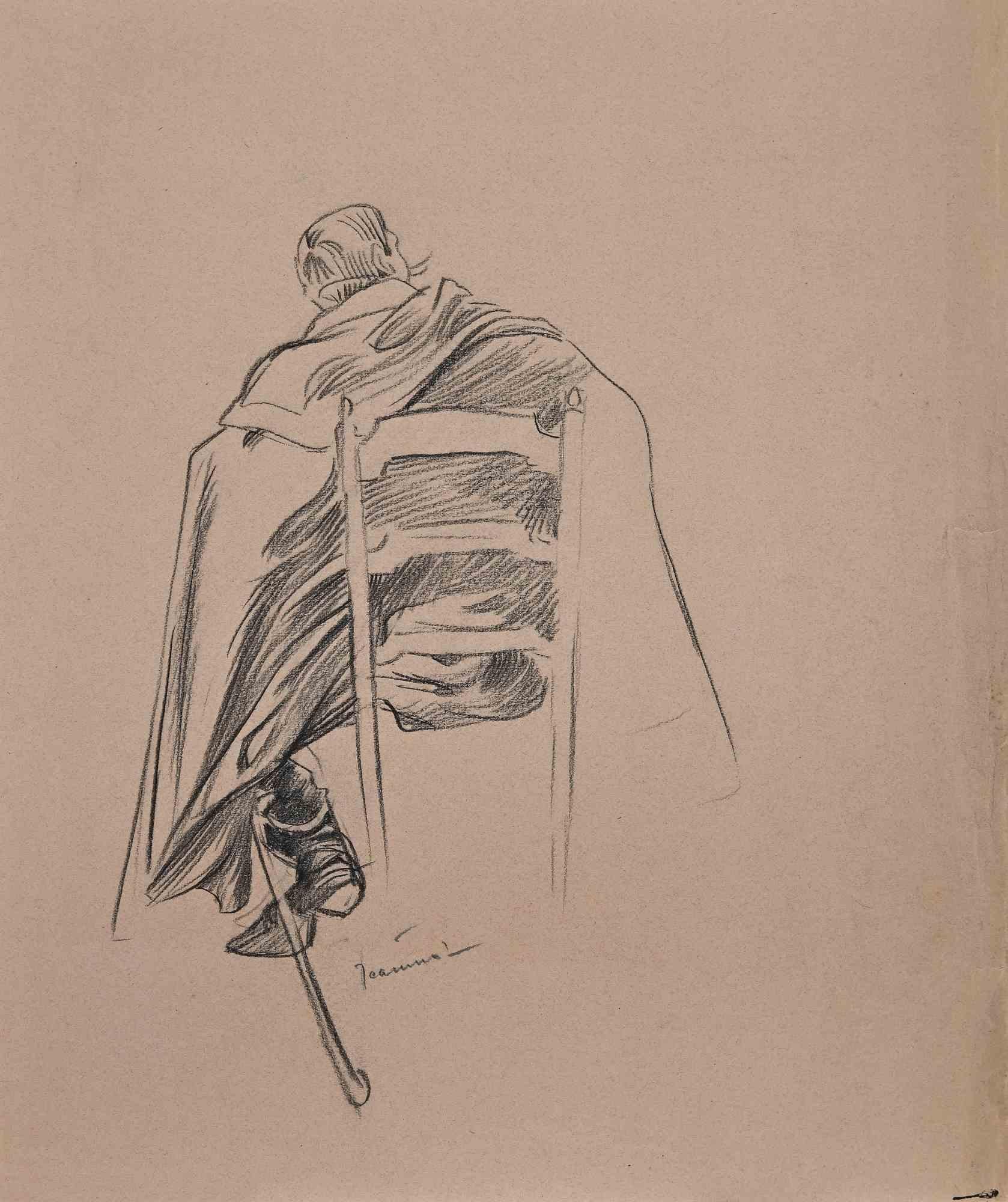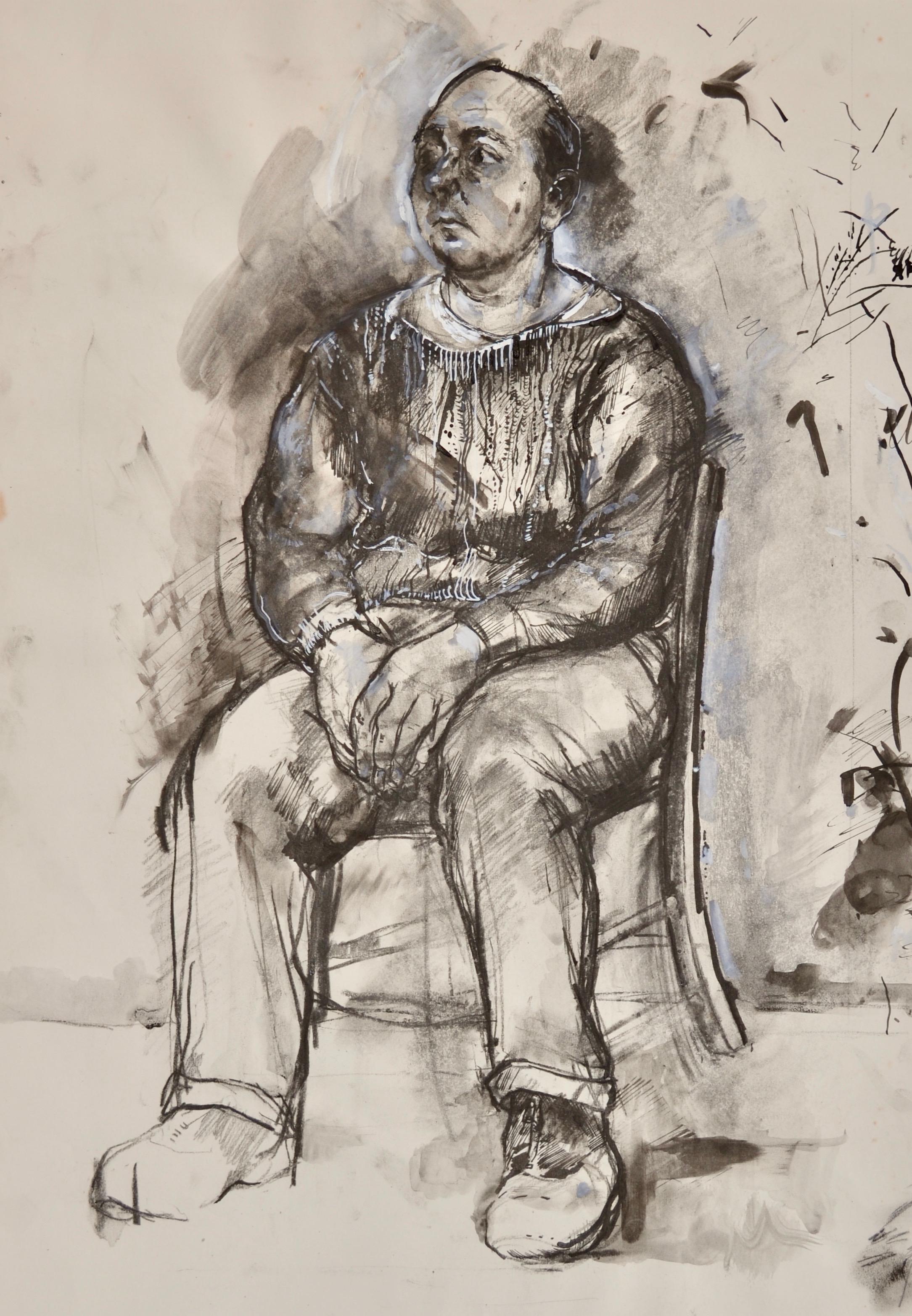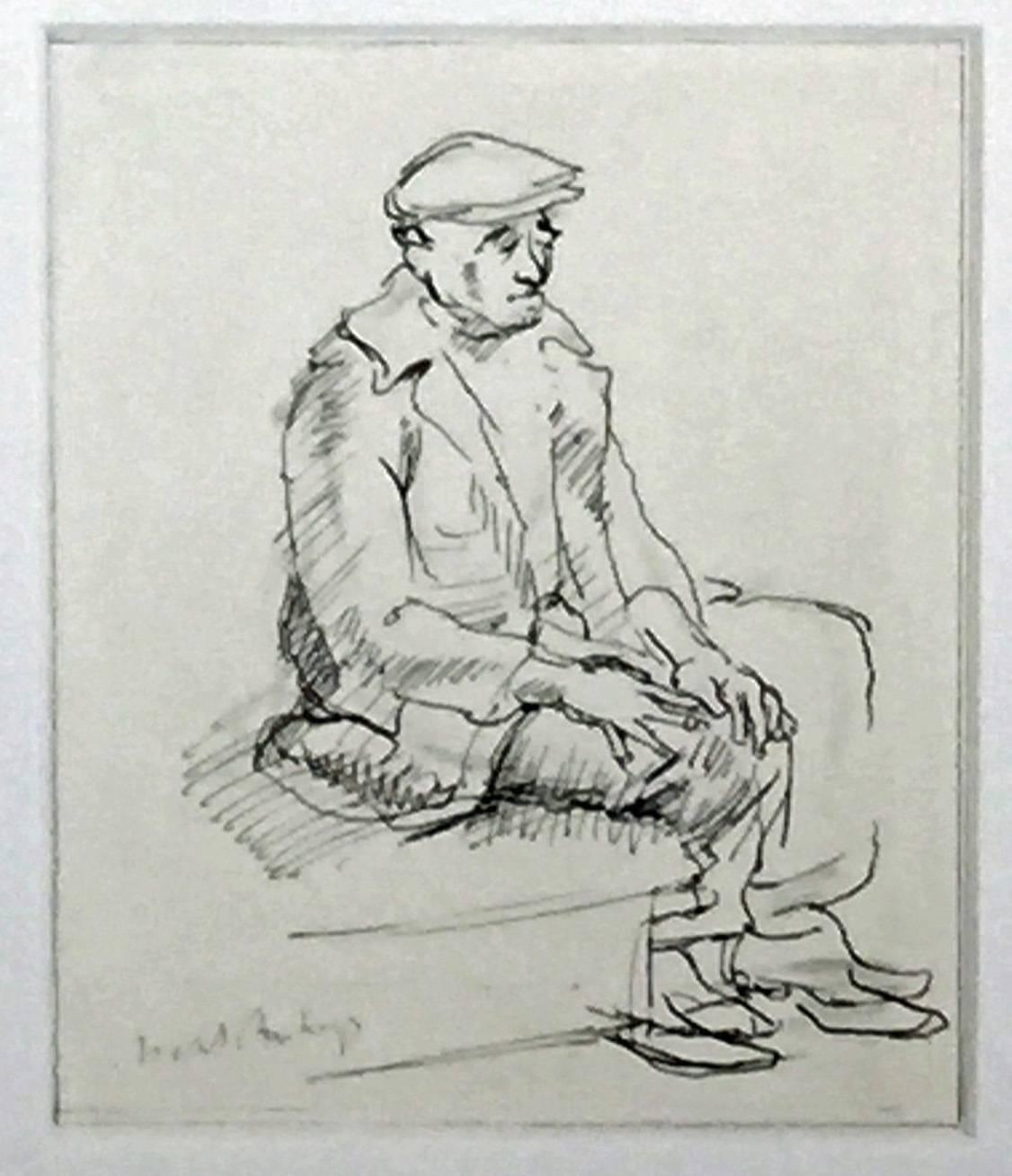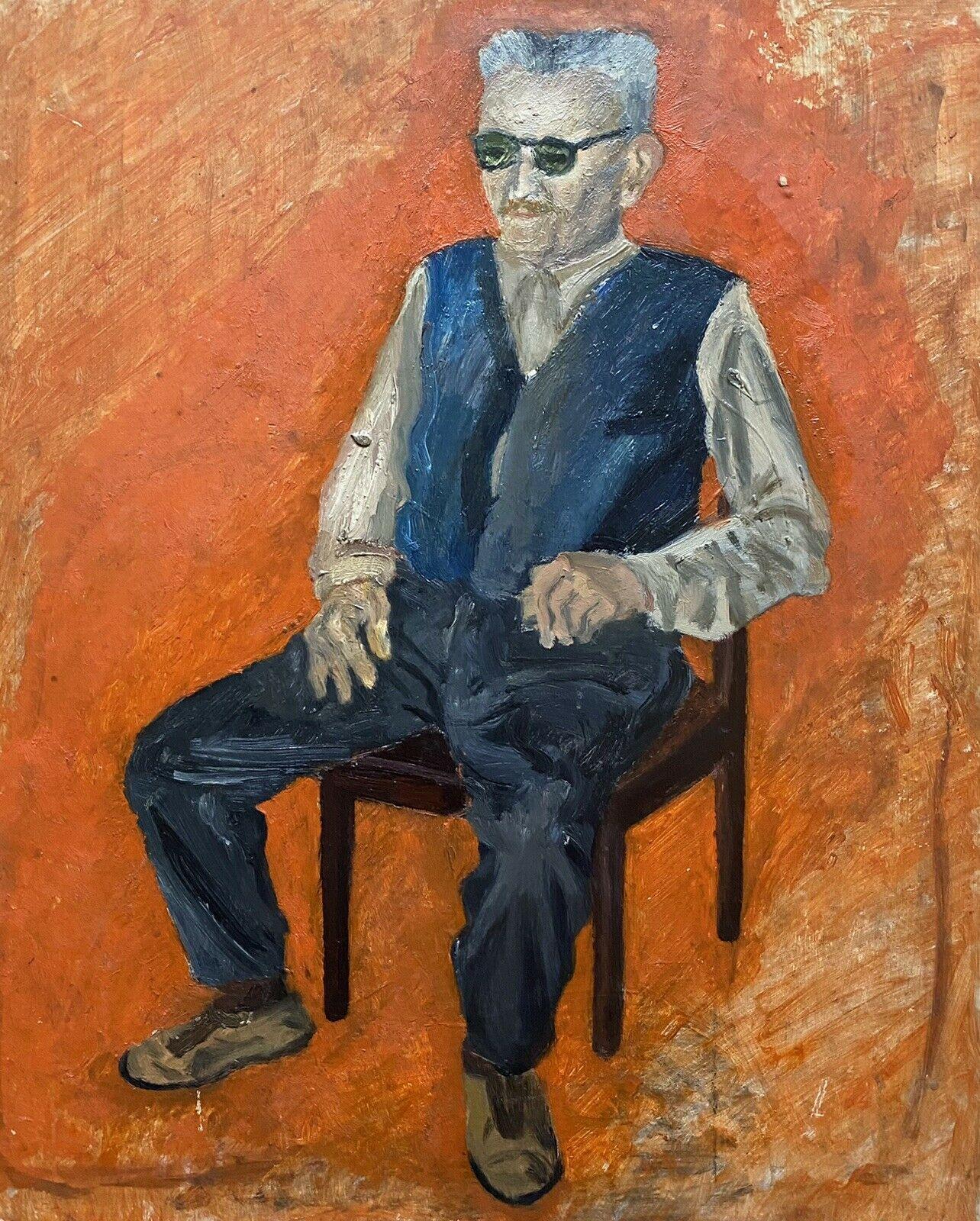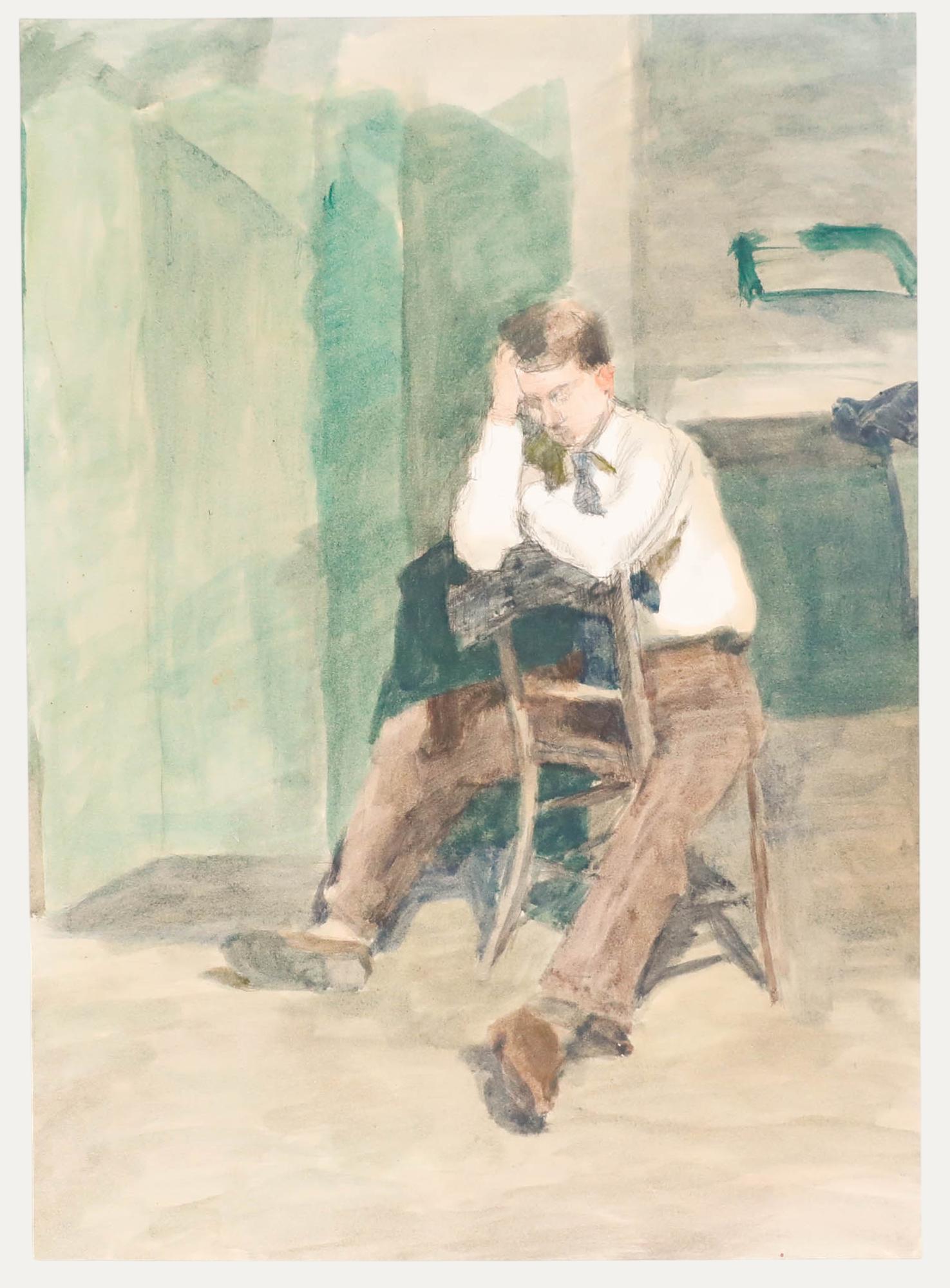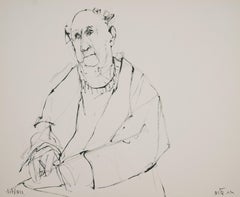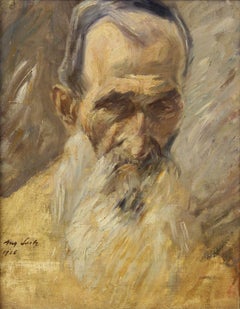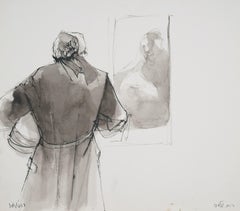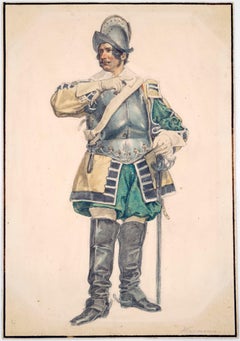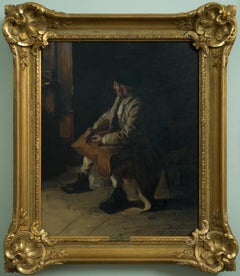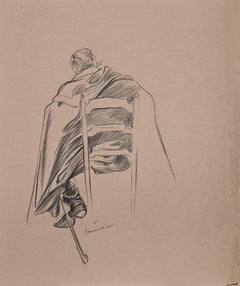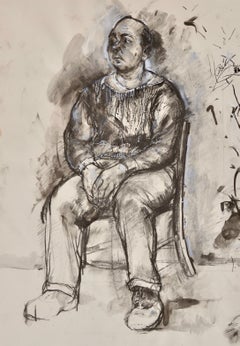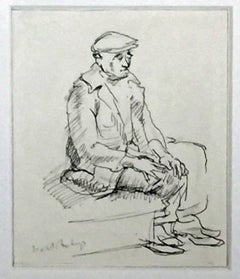Items Similar to Man sitting in the studio - Thinking about art -
Want more images or videos?
Request additional images or videos from the seller
1 of 8
Otto von Faber du FaurMan sitting in the studio - Thinking about art -
$908.67
$1,135.8320% Off
£672.69
£840.8620% Off
€760
€95020% Off
CA$1,257.37
CA$1,571.7120% Off
A$1,386.22
A$1,732.7820% Off
CHF 725.23
CHF 906.5320% Off
MX$17,006.36
MX$21,257.9420% Off
NOK 9,129.16
NOK 11,411.4520% Off
SEK 8,537.21
SEK 10,671.5120% Off
DKK 5,789.21
DKK 7,236.5220% Off
About the Item
Adolph Eduard Otto von Faber du Faur (1828 Ludwigsburg - 1901 Munich). Man sitting in the studio. Watercolour painting, 43 x 27 cm (visible size), 73 x 53 cm (frame), monogrammed at lower right, estate stamp.
Upper right corner neatly repaired, small tear in the wall to the left of the sitter.
- Thinking about art -
About the artwork
The sitter, an elderly man, is seated in a studio on a pedestal reminiscent of an academy hall. The earthy, dark tones give the scene a weighty quality. The lightest tones are found in the incarnate parts of the figure, which do not stand out from the other colours of the picture, but are linked to them. As a result, the sitter's face is both part of and the highlight of the colour references in the picture. The colour of the sitter's skin is reflected in his pink coat, while his white-grey hair matches the colour of the wall next to him. This almost monochrome wall surface, in turn, is connected across the portrait to the framed picture standing on the floor, which seems to have been erased by this correspondence with the empty wall surface. Through the palette, which is positioned directly behind the sitter's head, the reference to painting, which is already given by the studio space, is explicitly linked to the sitter, who thus seems to be contemplating the question of the meaning of art.
This raises the question of whether Faber Du Faur, who had become lonely in his old age, might have painted a self-portrait here in his later years. In addition to the studio setting, the sitter's explicit reference to the palette and the fact that the picture was part of his estate, the only summary elaboration of the body suggests a self-portrait, while the representation of the face is concretised with the wide-open eyes typical of a self-portrait. This concentration on the face gives the impression of the artist's melancholy introspection, captured by the palette and related to the meaning of painting, whose dark character is reinforced by the concealment of the palette hanging on the right of the picture in the light tones so characteristic of Faber Du Faur. In the course of this resignation, Faber du Faur advises his son Hans, who has also become a painter: "Promise me one thing: never move to Munich, they'll kill you here!"
Whoever the sitter may be, the references to painting make the portrait a resigned self-contemplation by Faber Du Faur, focused on art.
About the artist
After leaving school, Otto Faber du Faur entered the service of the Württemberg army, at the same time cultivating his artistic talent. In 1851, on the recommendation of his father Christian Wilhelm, who was himself a battle painter, he spent six months in Munich as an apprentice to Alexander von Kotzebue. In 1852 he was granted a year's leave of absence from military service to study battle painting in the studio of Adolphe Yvon in Paris, where he received a scholarship from the Württemberg royal family. In Paris, he was inspired by the paintings of Théodore Géricault and Eugène Delacroix. On further study trips to Paris, Faber Du Faur also became acquainted with the art of Gustave Courbet, Théodore Rousseau and Adolphe Monticelli. In 1867, he resigned from the army to devote himself entirely to art. In 1869 he became a pupil of Karl von Piloty at the Munich Academy, one of the most innovative history painters of his time. In the 1970s, he was commissioned by the royal house of Württemberg to produce several large paintings that established Faber Du Faur's reputation as one of Germany's leading battle painters. The great success of his panorama 'The Siege of Paris', which was exhibited at the Paris Universal Exhibition of 1878, led to the production of a large number of panoramas, which were gradually painted and exhibited in various large cities. In 1880, Faber Du Faur undertook a study trip to Tunis, followed by a six-month stay in Morocco in 1883, which led to a marked brightening of his palette and a more expressive use of colour. A development that he continued on his travels to Spain, but which made him an outsider who died in obscurity in Munich in 1901. The quality of his art was only rediscovered and appreciated posthumously: four of his works were shown at the Venice Biennale in 1903 and, as a temporary high point, a major monographic exhibition of 160 of his paintings was held at the National Gallery in Berlin in 1927.
His correspondence with his painter friend Carl von Häberlin, which gives an insight into his work, is in the Württembergische Landesbibliothek in Stuttgart.
Selection of public collections that own works by Otto von Faber du Faur:
Bayerisches Armeemuseum Ingolstadt, Kunstmuseum Stuttgart, Galleria d’Arte Moderna Triest, Lenbachhaus München, Nationalgalerie Berlin, Neue Pinakothek München, Staatsgalerie Regensburg, Staatsgalerie Stuttgart.
Selected Bibliography
Theodor Musper: Schwäbische Lebensbilder, Stuttgart 1941.
Peter Wilhelm Pech: Carl von Häberlin, Tübingen 1982.
Julius Fekete: Carl von Häberlin und die Stuttgarter Historienmaler seiner Zeit, Sigmaringen 1986.
Claus Zoege von Manteuffel (Hg.): Kunst und Künstler in Württemberg, Stuttgart 1996.
Gertrud Seizinger: Otto von Faber du Faur. Studien zu den Arbeiten in Öl, Stuttgart 2010.
GERMAN VERSION
Adolph Eduard Otto von Faber du Faur (1828 Ludwigsburg - 1901 München). Im Atelier sitzender Mann. Aquarell, 43 x 27 cm (Passepartout-Innenmaß), 73 x 53 cm (Rahmen), rechts unten monogrammiert, verso Nachlass-Stempel der Rückseite als Fotografie auf den rückwärtigen Schutzkarton angeheftet.
Rechte obere Ecke sachgemäß ergänzt, kleiner Einriss auf der Wandpartie links vom Porträtierten.
Exposé als PDF
- Über die Kunst sinnierend -
zum Werk
Der porträtierte ältere Mann sitzt in einem Atelier auf einem an Akademiesäle gemahnenden Sockel. Die erdig-dunkeltonige Farbigkeit verleiht der Szene eine Schwere. Den hellsten Farbwert bildet das Inkarnat, das sich allerdings nicht von der sonstigen Farbigkeit des Bildes abhebt, sondern an diese zurückgebunden ist. Dadurch ist das Antlitz des Porträtierten zugleich Teil wie Höhepunkt der farblichen Bildbezüge. So findet sich die Hautfarbe in abgeschwächter Weise im rosafarbenen Mantelaufschlag wieder während die weißlich grauen Haare tonal mit der Wandfläche neben dem Porträtierten korrespondierenden. Diese nahezu monochrome Wandfläche verbindet sich über den Porträteren hinweg wiederum mit dem auf der Erde stehenden gerahmten Bild, das durch diese Entsprechung mit der leeren Wandfläche wie ausgelöscht wirkt. Anhand der genau hinter dem Kopf des Porträtierten situierten Palette wird der bereits durch den Atelierraum gegebene Bezug zur Malerei ausdrücklich auf den Dargestellten bezogen, der dadurch über die Frage nach dem Sinn der Kunst zu sinnieren scheint.
Damit ist die Frage aufgeworfen, ob sich der im Alter vereinsamte Faber Du Faur hier nicht in seinen späten Lebensjahren selbst porträtiert haben könnte. Neben der Ateliersituation, dem ausdrücklichen Bezug des Porträtierten auf die Palette und dem Umstand, dass sich das Bild im Nachlass befunden hat, spricht für ein Selbstporträt auch die einzig summarisch erfolgte Ausarbeitung des Körpers während sich die Darstellung im Gesicht mit den für ein Selbstporträt topischen weit geöffneten Augen konkretisiert. Diese Verdichtung im Gesicht forciert den Eindruck einer von der Palette hinterfangenen, auf den Sinn der Malerei bezogene melancholische Innenschau eines Künstlers, deren dunkler Zug noch durch die Verdeckung der rechts im Bild hängenden Palette mit jenen für Faber Du Faur doch so charakteristischen hellen Tönen verstärkt wird. Im Zuge dieser Resignation rät Faber du Faur seinem Sohn Hans, der ebenfalls Maler geworden ist: „Versprich mir nur eines, zieh nie nach München, sie bringen dich hier um!“ Um wen auch immer es sich bei dem dargestellten Mann tatsächlich handeln mag, anhand der hervorgehobenen Bezüge auf die Malerei ist das Porträt eine auf die Kunst fokussierte resignative Selbstbesinnung Faber Du Faurs.
zum Künstler
Otto Faber du Faur trat nach der Schule in den Dienst der Württembergischen Armee und kultivierte - parallel dazu - seine künstlerische Begabung. 1851 ging er auf Empfehlung seines Vaters Christian Wilhelm, der seinerseits Schlachtenmaler war, ein halbes Jahr in München bei Alexander von Kotzebue in die Lehre. 1852 wurde er dann ein ganzen Jahr vom Heerdienst beurlaubt, um sich - mit einem Stipendium des Württembergischen Königshauses bedacht - in Paris im Atelier von Adolphe Yvon in der Schlachtenmalerei weiterzubilden. In Paris wurde er durch die Malerei von Théodore Géricault und Eugène Delacroix inspiriert. Auf weiteren Pariser Studienreisen machte sich Faber Du Faur dann auch mit der Kunst Gustave Courbets, Théodore Rousseaus und Adolphe Monticellis vertraut. 1867 nahm er seinen Abschied von der Armee, um sich ganz der Kunst zu widmen. 1869 wurde er an der Münchner Akademie Schüler Karl von Pilotys, einem der innovativsten Historienmaler seiner Zeit. In den siebziger Jahren entstanden im Auftrag des Württembergischen Königshauses mehrere großformatige Gemälde, welche Faber Du Faurs Ruf als bedeutender deutscher Schlachtenmaler begründeten. Der große Erfolg seines während der Pariser Weltausstellung von 1878 gezeigten Panorama "Belagerung von Paris" zog die Anfertigung einer Vielzahl von Panoramen nach sich, die nach und nach in den verschiedensten Großstädten gemalt und gezeigt wurden. 1880 unternahm Faber Du Faur eine Studienreise nach Tunis, um dann, 1883, ein halbes Jahr nach Marokko zu gehen, was zu einer deutlichen Aufhellung seiner Palette und einem expressiveren Farbumgang führte. Eine Entwicklung, die er auf Reisen nach Spanien weiter beförderte, ihn aber zu einem Außenseiter machte, der 1901 unbeachtet in München verstarb. Die Qualität seiner Kunst wurde erst posthum wiederentdeckt und gewürdigt: 1903 wurden vier seiner Werke auf der Biennale in Venedig gezeigt und, als vorläufiger Höhepunkt, fand 1927 in der Nationalgalerie Berlin eine große monografische Ausstellung statt, auf der 160 seiner Gemälde zu sehen waren.
Der einen Einblick in sein Schaffen gewährende Briefwechsel mit seinem Malerfreund Carl von Häberlin liegt in der Württembergischen Landesbibliothek Stuttgart.
Auswahl öffentlicher Sammlungen, die Werke von Otto von Faber du Faur besitzen:
Bayerisches Armeemuseum Ingolstadt, Kunstmuseum Stuttgart, Galleria d’Arte Moderna Triest, Lenbachhaus München, Nationalgalerie Berlin, Neue Pinakothek München, Staatsgalerie Regensburg, Staatsgalerie Stuttgart.
Auswahlbibliographie
Theodor Musper: Schwäbische Lebensbilder, Stuttgart 1941.
Peter Wilhelm Pech: Carl von Häberlin, Tübingen 1982.
Julius Fekete: Carl von Häberlin und die Stuttgarter Historienmaler seiner Zeit, Sigmaringen 1986.
Claus Zoege von Manteuffel (Hg.): Kunst und Künstler in Württemberg, Stuttgart 1996.
Gertrud Seizinger: Otto von Faber du Faur. Studien zu den Arbeiten in Öl, Stuttgart 2010.
- Creator:Otto von Faber du Faur (1828 - 1901, German)
- Dimensions:Height: 16.93 in (43 cm)Width: 10.63 in (27 cm)
- Medium:
- Movement & Style:
- Period:
- Condition:
- Gallery Location:Berlin, DE
- Reference Number:1stDibs: LU2438212325942
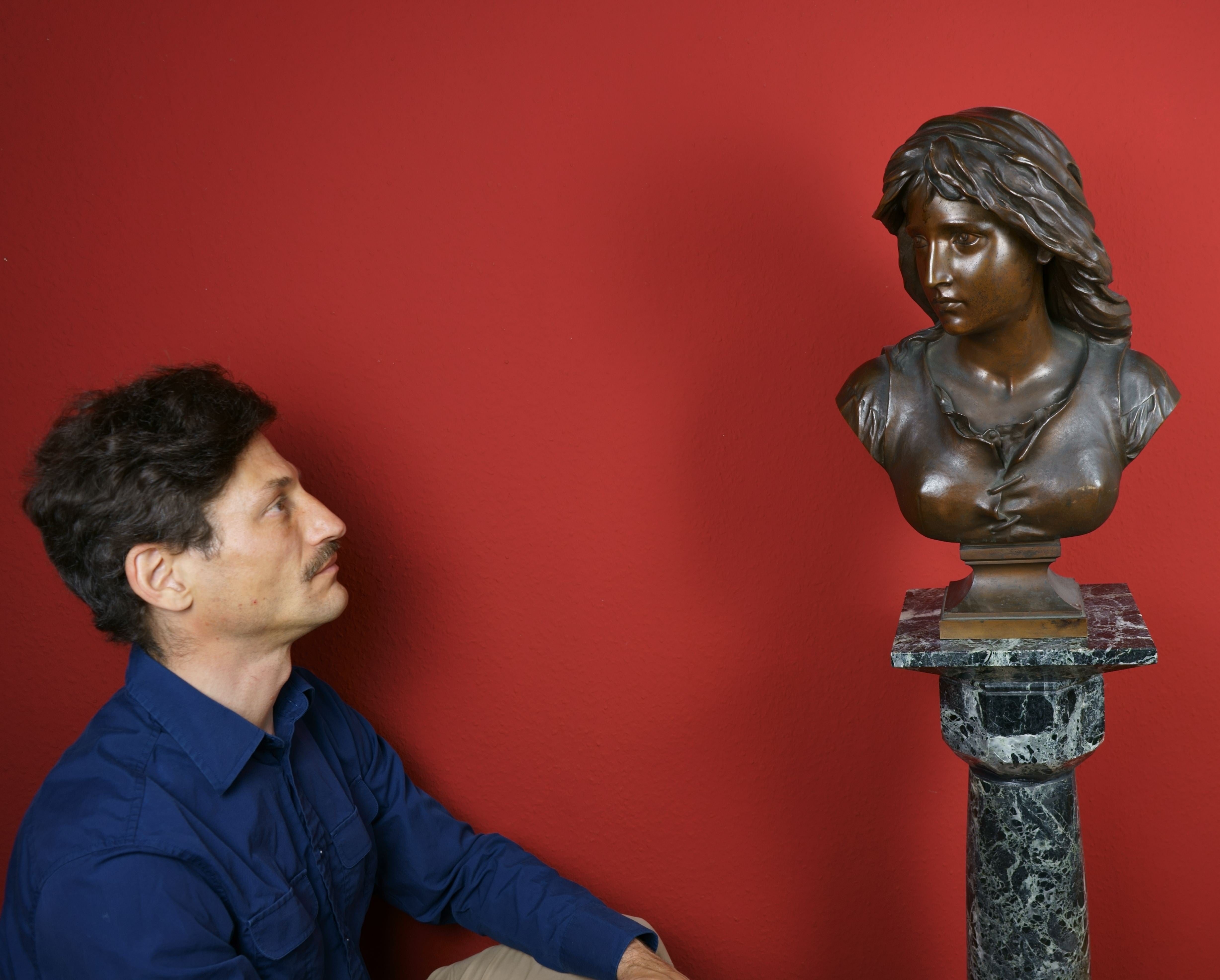
About the Seller
5.0
Vetted Professional Seller
Every seller passes strict standards for authenticity and reliability
Established in 2014
1stDibs seller since 2023
21 sales on 1stDibs
- ShippingRetrieving quote...Shipping from: Berlin, Germany
- Return Policy
Authenticity Guarantee
In the unlikely event there’s an issue with an item’s authenticity, contact us within 1 year for a full refund. DetailsMoney-Back Guarantee
If your item is not as described, is damaged in transit, or does not arrive, contact us within 7 days for a full refund. Details24-Hour Cancellation
You have a 24-hour grace period in which to reconsider your purchase, with no questions asked.Vetted Professional Sellers
Our world-class sellers must adhere to strict standards for service and quality, maintaining the integrity of our listings.Price-Match Guarantee
If you find that a seller listed the same item for a lower price elsewhere, we’ll match it.Trusted Global Delivery
Our best-in-class carrier network provides specialized shipping options worldwide, including custom delivery.More From This Seller
View AllContemplating old man / - The View into Life -
By Ruth Schloss
Located in Berlin, DE
Ruth Schloss (1922 Nuremberg - 2013 Kfar Shmaryahu), Contemplating old man, around 1990. Mixed media on watercolor paper, 33 cm x 40 cm, signed “Schloss” lower left and again in Hebr...
Category
1990s Realist Figurative Drawings and Watercolors
Materials
Paper
Half-length portrait of an elderly bearded man - Melancholy of a prophet -
Located in Berlin, DE
Friedrich August Seitz (1902 Staffort - 1944 Belgrade). Half-length portrait of an elderly man with a beard. Oil on canvas, 42 x 34 cm (visible seize), 58 x 50 cm (frame), signed and...
Category
1920s Expressionist Figurative Paintings
Materials
Oil
Old man in front of a mirror / - Diffusion -
By Ruth Schloss
Located in Berlin, DE
Ruth Schloss (1922 Nuremberg - 2013 Kfar Shmaryahu), Old man in front of a mirror, around 1990. Mixed media on watercolor paper, 33.5 cm x 40 cm, signed “Schloss” lower left and agai...
Category
1990s Realist Figurative Drawings and Watercolors
Materials
Paper
The actor Karl Seydelmann, probably as Max Piccolomini / - Theatrical Realism -
Located in Berlin, DE
Theodor Hosemann (1807 Brandenburg - 1875 Berlin), The actor Karl Seydelmann probably as Max Piccolomini, around 1840. Watercolor with pencil, 20.5 cm (height) x 14.7 cm (width), sig...
Category
1840s Realist Figurative Drawings and Watercolors
Materials
Paper
The actor Karl Seydelmann as soldier / - The expressiveness of a simple pose -
Located in Berlin, DE
Theodor Hosemann (1807 Brandenburg - 1875 Berlin), The actor Karl Seydelmann as soldier, around 1840. Watercolor in pencil, 22 cm (height) x 14.7 cm (width), signed “Th.[eodor] Hosem...
Category
1840s Realist Figurative Drawings and Watercolors
Materials
Paper
Man in a wheelchair / - Looking to the future -
By Ruth Schloss
Located in Berlin, DE
Ruth Schloss (1922 Nuremberg - 2013 Kfar Shmaryahu), Man in a wheelchair, around. 1990. Mixed media on watercolor paper, 38.5 cm x 33 cm, signed “Schloss” lower left and again in Heb...
Category
1990s Realist Figurative Drawings and Watercolors
Materials
Paper
You May Also Like
The Seated Man – An Intimate Glimpse into Daily Life
Located in Stockholm, SE
This masterfully executed painting by Emerik Stenberg (1873–1927) captures an intimate and atmospheric moment. The composition features a seated man, engrossed in his daily chores, b...
Category
Early 20th Century Realist Figurative Paintings
Materials
Canvas, Oil
Man Sitting - Drawing by G. Jeanniot - Late 19th Century
By Pierre Georges Jeanniot
Located in Roma, IT
Man Sitting is an Original Pencil Drawing realized by Pierre Georges Jeanniot (1848-1934).
Hand-Signed by the artist on the lower margin.
Good condition on a brown colored cardboa...
Category
Late 19th Century Modern Drawings and Watercolor Paintings
Materials
Pencil
Seated Man - 20th Century British figure drawing by Carolyn Sergeant
Located in London, GB
CAROLYN SERGEANT
(1937-2018)
Seated Man in a Pullover
Signed beneath the mount
Chalk and grisaille wash over traces of pencil, heightened with white
Unframed in mount only
53 by ...
Category
Late 20th Century Realist Figurative Drawings and Watercolors
Materials
Watercolor, Chalk
SEATED MAN
By Isabel Bishop
Located in Portland, ME
Bishop, Isabel. SEATED MAN. Ink drawing on paper, c. 1932. 5 1/4 x 4 3/4 inches. Signed in pencil.
Category
1930s American Realist Prints and Multiples
Materials
Ink
$520 Sale Price
20% Off
GENEVIEVE ZONDERVAN (1922-2013) FRENCH OIL PAINTING - PORTRAIT OF SEATED MAN
Located in Cirencester, Gloucestershire
"Seated Man"
by Geneviève Zondervan (French 1922-2013)
oil painting on board
board: 18 x 14.75 inches
Very fine 20th century oil painting on board by the French artist, Geneviève Z...
Category
Late 20th Century Surrealist Portrait Paintings
Materials
Oil
Pauline Plummer (b.1933) - 20th Century Watercolour, Boy Seated
Located in Corsham, GB
A sensitive life study by the artist Pauline Plummer (b.1933). The artist has expertly captured the subject in a loose, sketchy style. Unsigned. On paper laid to card.
Category
20th Century Portrait Drawings and Watercolors
Materials
Watercolor
More Ways To Browse
Painting Seated Man
Large Painting Monochrome Painting
Man In Hat Painting
Lonely Man
Sitting Man
Morocco Dior
Large Battle Scene Painting
Karl Otto
Antique Battle Painting
Fur Hat Used
Karl Alexander
Antique Military Painting
Theodore Gericault
Great Exhibition 1851
Dior Coat 1970s
Eugene Otto
Adolphe Yvon
Carl Wilhelms
